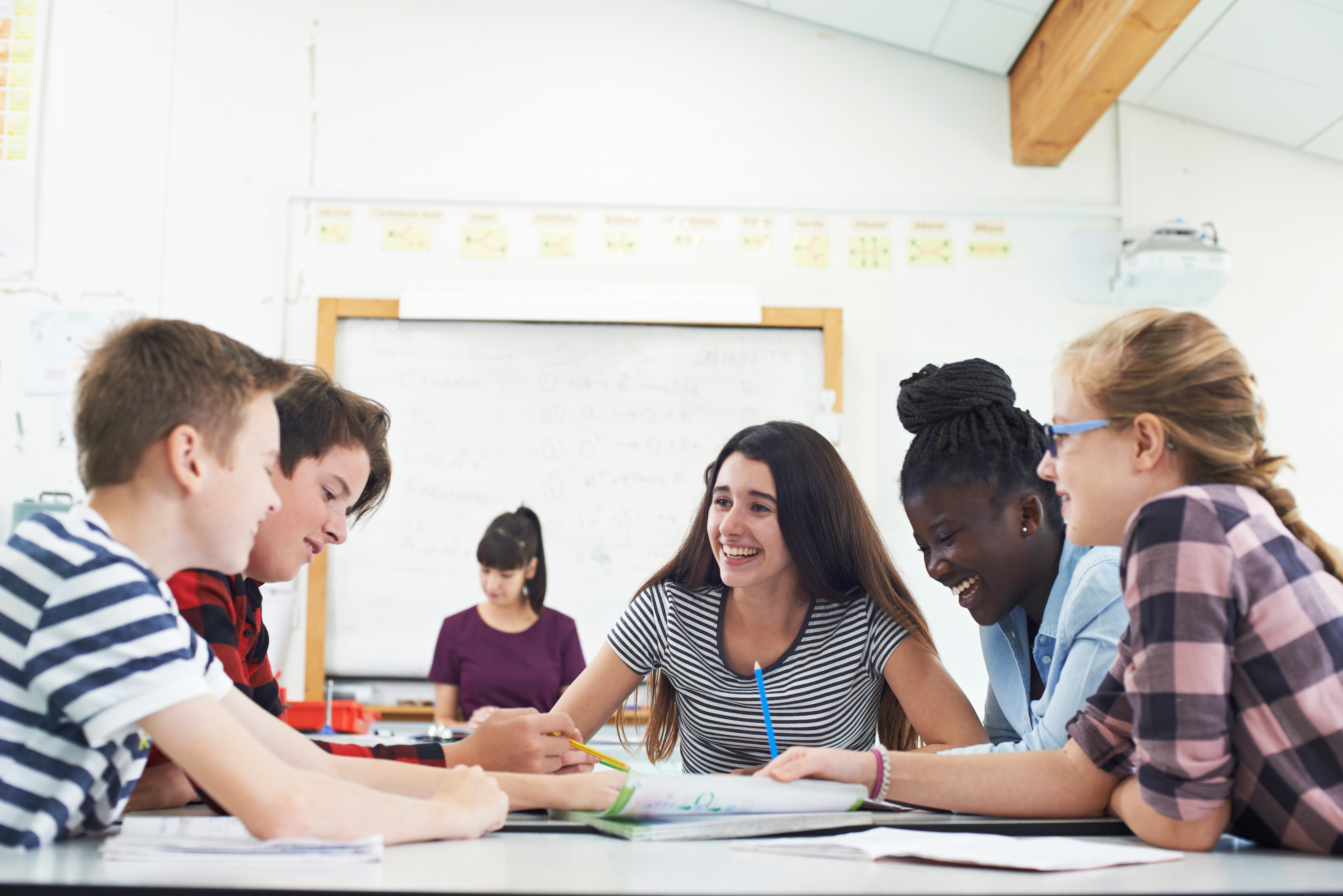Community-Building + Personal Development Activities for High School Students
Developing interpersonal skills is a fundamental part of PreK-12 education, especially for high school students navigating the complex terrain of adolescence. Effective community-building activities help students foster a sense of belonging within their school communities and develop a sense of purpose as individuals.
Wayfinder’s theory of change is that students who experience belonging and are guided by purpose are best supported and motivated to live meaningful, fulfilling lives and to make a positive impact on the world around them. For that reason, belonging and purpose are at the heart of high school community building. When planning and facilitating activities to foster belonging and purpose, an important factor to keep in mind—especially at the high school level—is that the activities brought to the classroom must always feel authentic and relevant to students.
Building Belonging
Creating a sense of belonging is fundamental to a healthy and thriving school culture. High school students who feel connected to their peers and school are more likely to thrive academically and emotionally. Activities that build community and foster positive relationships can help students feel valued and supported. Consider the following community-building activities and strategies.
- Inclusive Group Activities: Incorporate team-building exercises that encourage collaboration and help students develop effective communication and empathy.
- Peer Mentoring: Establish ways for older students to mentor younger ones and for peers to offer each other guidance. This can help students develop strong relationships, build agency and self-efficacy, and feel like integral parts of their school community.
- Community Circles + Restorative Practices: Regularly hold circles where students can share their thoughts and feelings in a safe, respectful space. You can then use this familiar format for facilitating restorative practices in response to conflicts, tragedies, or issues that arise on campus.
Developing Purpose
High school students are at a stage where they begin to explore their identities and future aspirations. Personal development activities that help students discover their interests and set personal goals can instill purpose. The following strategies can effectively help students find meaningful direction in school.
- Identifying Values: Help students identify their core values through reflection and discussion. Activities that connect classroom learning to these values can reinforce the importance of education in their personal growth.
- Goal-Setting + Progress Monitoring: Guide students in setting short-term and long-term goals. Regularly monitor their progress and encourage them to reflect on their achievements and setbacks. This process helps students develop a growth mindset and resilience.
- Career Exploration: Provide opportunities for students to explore various careers through internships, job shadowing, or guest speakers. This exposure can help students connect their interests and values to potential career paths.
Making Learning Relevant
Learning is most effective and easiest to commit to long-term memory when it resonates with students and their experiences. If efforts to build belonging and purpose feel contrived or disconnected from students’ realities, students are unlikely to engage. However, when students see the relevance of learning to their daily lives, they are more likely to learn, reflect on, and apply the skills they learn to situations they encounter. To ensure relevance, consider the following:
- Use Real-Life Scenarios: Use scenarios and role-playing activities that reflect the challenges students face in their daily lives.
- Incorporate Student Perspectives: Learn about your students' backgrounds to design activities that are inclusive and reflective of the rich diversity of experiences at your school.
- Student Voice + Choice: Involve students in the planning and selection of activities to ensure they are meaningful and relevant.
- Using Flexible Learning Tools: Customizable resources like Wayfinder’s Activity Library and Collections enable educators to tailor instruction to students’ interests. As part of the professional learning journey with Wayfinder, educators learn how to customize the curriculum and activities for maximum impact. This flexibility allows teachers to adapt lessons to fit the unique needs and interests of their students, making the learning experience more engaging and relevant.
High-Impact High School Activities to Build Community + Encourage Personal Development
Belonging, purpose, and relevance are critical components of whole-student instruction in high school, but what do activities around these topics actually look like? They can take various forms, with different time commitments, complexity levels, and teacher preparation. Many are incredibly quick and easy to implement, some require a commitment to routine, and a few may even extend beyond classroom walls.
Icebreakers + Team-Building Activities
Starting with icebreakers and team-building exercises can effectively create a sense of community and trust among students, making these activities a critical part of any teacher’s toolkit for building belonging. For example, the game "Two Truths + a Lie" invites students to share two true statements and one false statement about themselves. Games like this are more than just icebreakers; they encourage students to reveal parts of their personality and life experiences, starting conversations and building connections in a fun and low-pressure environment. Connections made through activities like these pay off in greater mutual trust and respect that encourages classroom participation and collaboration throughout the year.
Group challenges, such as scavenger hunts and physical challenges, are also highly effective. These activities require students to work together to solve problems and achieve common goals. The collaborative nature of these challenges helps break down social barriers, build trust, and promote a sense of belonging. When students successfully complete a task together, they not only feel accomplished but also more connected to their peers.
Reflection + Journaling
Reflection is a powerful tool for building self-awareness and learning strategies for self-management. By providing guiding prompts, educators can help students process their emotions and experiences and emerge more adaptable, resilient, and purpose-driven. For instance, a daily reflection prompt like, “What was a challenge you faced today, and how did you overcome it?” encourages students to think critically about their day and their responses to various situations. This practice helps students develop a deeper understanding of themselves and improves their ability to manage their emotions and behaviors.
Reflection and journaling can be applied to a range of topics. In goal-setting journals, for example, students can set personal goals, track their progress, and reflect on their achievements and setbacks. This ongoing process of setting and evaluating goals helps students develop a growth mindset and skills to navigate uncertainty with confidence in their abilities and a commitment to their values.
Another beneficial aspect of reflective journaling is the development of a gratitude practice. Research has shown that practicing gratitude can enhance well-being and life satisfaction. By incorporating prompts that encourage students to reflect on what they are thankful for, educators can help students cultivate a positive outlook and easily identify human and material resources in their lives. Gratitude reflection not only boosts mood and optimism but also builds resilience and emotional strength.
Role-Plays + Scenarios
Role-playing activities are particularly effective in helping students practice social awareness and relationship skills. By navigating common social situations through role-playing, students can develop empathy and learn to handle conflicts constructively. For example, educators can create scenarios where students practice resolving conflicts. This type of activity helps teach practical conflict-resolution skills while also helping students understand different perspectives and the importance of empathy.
Explicit empathy exercises, where students envision and role-play situations from different perspectives, can also be incredibly valuable. These exercises help students develop a deeper understanding of their peers' experiences and emotions, fostering a more inclusive and supportive school environment. Beyond that, perspective-taking activities build students’ empathy, critical thinking skills, and ability to make decisions with a concern for the common good.
Stress Management + Well-Being
Teaching students tools for managing stress and promoting their well-being is crucial for success in school and for their overall development. Incorporating mindfulness practices into the classroom routine can be highly beneficial. Mindfulness exercises, such as deep breathing and focusing techniques, can help students become more aware of their thoughts and feelings and find a sense of calm and focus in high-pressure situations. It’s best to vary mindfulness exercises so that students can try out different strategies and choose the practices that resonate with them, making it easier for them to incorporate these techniques into their daily lives.
Engaging students in physical activity is another effective strategy for managing stress and promoting well-being. Physical activity has been shown to reduce stress and improve mood, making it a valuable addition to the classroom environment. Incorporating short bursts of physical activity, such as stretching or quick movement breaks, can help students release tension and re-energize, ultimately boosting their attention and focus during lessons.
Additionally, teaching practical stress-management techniques can equip students with valuable skills for their future academic and professional endeavors. Activities that focus on time management, organization, and relaxation strategies can help students develop productive habits that alleviate stress and improve their ability to cope with challenges. For example, teaching students how to prioritize tasks and manage their time effectively can reduce feelings of overwhelm, enhance their academic performance, and prepare them to be self-sufficient in postsecondary and professional settings.
Identifying Values + Getting Involved
Encouraging students to find causes that align with their values and get involved can significantly enhance their sense of purpose and well-being. Research indicates that helping others can improve life satisfaction, well-being, and health outcomes. Purpose-focused activities that help students identify the causes that are important to them can get them started on a path toward meaningful contribution.
The first step in this work is helping students identify their values through reflection and discussion. Educators can then provide information on various causes and organizations that align with these values, helping students explore local and global causes as well as possible related career paths. In spaces like advisory and careers classes, teachers with the capacity to facilitate volunteer opportunities, such as organizing a food drive, participating in environmental initiatives, or supporting local community services, can enable students to actively contribute to their chosen causes and explore paths related to them.
After participating in these activities, students can reflect on their experiences and how they align with their personal values and goals. This reflection helps students internalize the importance of contributing to causes they care about, further enhancing their sense of purpose and overall well-being.
Using Assessments to Inform Activity Selection
Assessments are powerful tools for gaining insights into students' strengths and needs. Beyond their ability to gauge academic skill mastery, they can also enable educators to choose activities that effectively support their personal development. By understanding where students excel and where they need support, educators can tailor their instruction and interventions to maximize impact.
- Formative Assessments/Classroom Screening Tools: Conduct regular formative assessments to monitor students' ongoing progress and adjust personal skill development activities as needed. Formative assessments provide immediate feedback, helping educators identify areas where students may need additional support. They can also serve as screening tools to assess the overall climate of the classroom. They help teachers identify collective areas of need and inform group activities that can address these challenges.
- Summative Assessments: Use summative assessments at the end of a term or school year to evaluate overall personal skill growth and effectiveness of the implemented activities. This data can guide future programming and intervention as well as professional development efforts to help educators target areas of exceptional student need.
- Personalized Activity Recommendations: Assessments like Wayfinder’s Waypoints automatically recommend activities based on assessment data. This ensures that interventions are timely, targeted, and responsive to each student's unique needs.
By integrating personal assessments like Waypoints into their practice, educators can create a responsive and dynamic whole-student learning approach that supports all students' holistic development.
Engaging high school students in community building and personal development requires a thoughtful plan that addresses students' unique developmental needs and personal experiences. By focusing on activities that build belonging, foster purpose, and manage stress, educators can create a supportive and dynamic learning environment.
Using flexible learning tools and assessments ensures that programming is tailored to the specific needs of each student, making the learning experience both relevant and impactful. Leveraging these strategies can empower students to navigate their high school years with resilience, empathy, and a strong sense of self.
Leadership Curriculum for High School Students
Explore our collection of resources meant to help students lead meaningful and purposeful lives.





